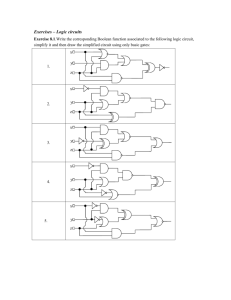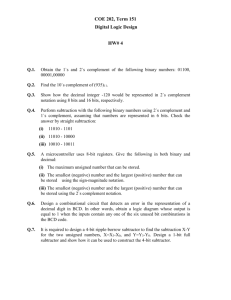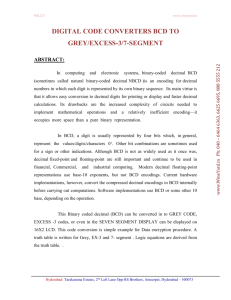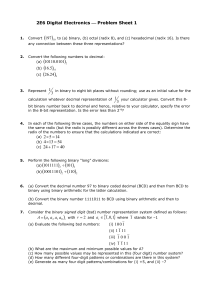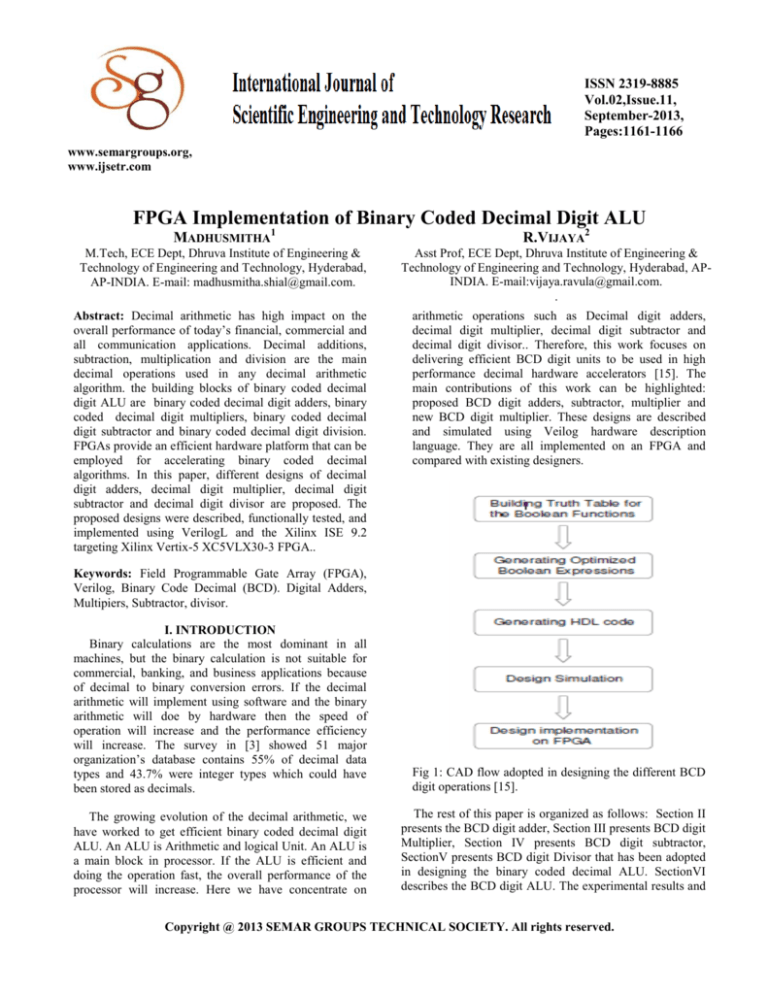
ISSN 2319-8885
Vol.02,Issue.11,
September-2013,
Pages:1161-1166
www.semargroups.org,
www.ijsetr.com
FPGA Implementation of Binary Coded Decimal Digit ALU
MADHUSMITHA1
R.VIJAYA2
M.Tech, ECE Dept, Dhruva Institute of Engineering &
Technology of Engineering and Technology, Hyderabad,
AP-INDIA. E-mail: madhusmitha.shial@gmail.com.
Asst Prof, ECE Dept, Dhruva Institute of Engineering &
Technology of Engineering and Technology, Hyderabad, APINDIA. E-mail:vijaya.ravula@gmail.com.
.
Abstract: Decimal arithmetic has high impact on the
overall performance of today’s financial, commercial and
all communication applications. Decimal additions,
subtraction, multiplication and division are the main
decimal operations used in any decimal arithmetic
algorithm. the building blocks of binary coded decimal
digit ALU are binary coded decimal digit adders, binary
coded decimal digit multipliers, binary coded decimal
digit subtractor and binary coded decimal digit division.
FPGAs provide an efficient hardware platform that can be
employed for accelerating binary coded decimal
algorithms. In this paper, different designs of decimal
digit adders, decimal digit multiplier, decimal digit
subtractor and decimal digit divisor are proposed. The
proposed designs were described, functionally tested, and
implemented using VerilogL and the Xilinx ISE 9.2
targeting Xilinx Vertix-5 XC5VLX30-3 FPGA..
arithmetic operations such as Decimal digit adders,
decimal digit multiplier, decimal digit subtractor and
decimal digit divisor.. Therefore, this work focuses on
delivering efficient BCD digit units to be used in high
performance decimal hardware accelerators [15]. The
main contributions of this work can be highlighted:
proposed BCD digit adders, subtractor, multiplier and
new BCD digit multiplier. These designs are described
and simulated using Veilog hardware description
language. They are all implemented on an FPGA and
compared with existing designers.
Keywords: Field Programmable Gate Array (FPGA),
Verilog, Binary Code Decimal (BCD). Digital Adders,
Multipiers, Subtractor, divisor.
I. INTRODUCTION
Binary calculations are the most dominant in all
machines, but the binary calculation is not suitable for
commercial, banking, and business applications because
of decimal to binary conversion errors. If the decimal
arithmetic will implement using software and the binary
arithmetic will doe by hardware then the speed of
operation will increase and the performance efficiency
will increase. The survey in [3] showed 51 major
organization’s database contains 55% of decimal data
types and 43.7% were integer types which could have
been stored as decimals.
Fig 1: CAD flow adopted in designing the different BCD
digit operations [15].
The growing evolution of the decimal arithmetic, we
have worked to get efficient binary coded decimal digit
ALU. An ALU is Arithmetic and logical Unit. An ALU is
a main block in processor. If the ALU is efficient and
doing the operation fast, the overall performance of the
processor will increase. Here we have concentrate on
The rest of this paper is organized as follows: Section II
presents the BCD digit adder, Section III presents BCD digit
Multiplier, Section IV presents BCD digit subtractor,
SectionV presents BCD digit Divisor that has been adopted
in designing the binary coded decimal ALU. SectionVI
describes the BCD digit ALU. The experimental results and
Copyright @ 2013 SEMAR GROUPS TECHNICAL SOCIETY. All rights reserved.
R.VIJAYA, MADHUSMITHA
the comparisons are provided in Section VII. Finally, the
conclusion is given in Section VIII.
II. BCD DIGIT ADDER
The addition of two n-digit BCD numbers follows the
same procedure. After binary addition of any decimal pair,
the result is checked for correctness. Then, the correct
decimal carry output is passed to the next more significant
digit pair, to be added with the two decimal digits located in
the same position. The conditional addition of 6 in each
decimal digit position could be implemented using any 4-bit
binary carry-propagate adder architecture for each decimal
digit. The long carry chain for such BCD adder slows down
the addition operation.
Therefore, to improve the BCD adders speed, We have
implemented a direct BCD digit adder using a nine bit input,
five bit output combinational logic[1]. The nine bit inputs
are the two BCD input digits A and B plus the decimal carry
input Cin and the five bit outputs are the BCD digit of the
decimal sum S plus the decimal carry out Cout. The
combinational logic of this adder is constructed by
extracting the Boolean expressions for the BCD addition
result directly from the BCD input operands. the
combinational logic will represent numbers using the BCD
representation form, without any relation with the binary
numbering system. For example, to add (7 + 7 = 14), this
operation is translated to (0111 + 0111 = 10100)BCD. The
output result (10100) BCD is the BCD representation of the
decimal number 14. The most significant bit is the decimal
carry output generated from the addition operation, while
the other bits are the BCD summation digit. This is a
correction-free technique, since the addition result is in a
BCD form, and the need for correction is internally resolved
through the Boolean expressions of the addition result.
All possible combinations of the inputs are represented in
truth table. Since the inputs are nine bits, the number of
possible combinations is 29 = 512 but many of these
combinations are not valid since a BCD digit is less than
(10)10, while 4-bit number can take any value from 0 to
(15)10. This would help in minimizing the output logic
functions more.
TABLE I: Three Different Entries from the Truth
Table of The BCD Digit Adder
Inputs
cin a3a2a1a0
0
0111
0
1000
1
1001
b3b2b1b0
0111
0101
1001
Outputs
cout
s3s2s1s0
1
0100
1
0011
1
1001
Fig2: simulation output of BCD adder.
III. BCD DIGIT MULTIPLIER
Decimal digit multiplier is an integral building block of
any decimal multiplier. It produces two decimal digits as
a result of multiplying one multiplier decimal digit with
another multiplicand decimal digit. All well known
decimal digit multipliers use BCD-8421 encoding to
represent the decimal digits. In the digit-by-digit Look-up
Table approach, the bits of the multiplier BCD digit and
the multiplicand BCD digit are used to address a look-up
table, to produce the BCD digit product [8]. In [9], an
iterative BCD multiplier using digit-by-digit lookup table
technique is presented. A faster implementation was
described in [8]. The later uses the same look-up table
used in [9], but it uses a carry-save addition scheme to
add partial products, instead of the carry-propagate adder
International Journal of Scientific Engineering and Technology Research
Volume.02, IssueNo.11, September-2013, Pages:1161-1166
FPGA Implementation of Binary Coded Decimal Digit ALU
used in [9]. However, due to the wide range of digits
handled by the decimal system, digit-by-digit lookup table
multipliers are inefficient from both area and speed sides.
is 28 = 256. Among all these combinations only 100
combinations are valid and the rest are invalid[15].
TableII: Three Different Entries from the Truth Table
of the BCD Digit Multiplier
Inputs
Fig3: Expected implementation of the output functions of
the BCD digit multiplier on 6-input LUTs[15].
The BCD digit multiplier multiplies two BCD digits
to produce a two BCD digits product output. The
implemented direct BCD digit multiplier[13], word
”direct” means no need for neither ”first finding the
binary multiplication result and then converting the
product to a BCD form” as we are doing in traditional
multiplication. A simplified Boolean expressions impleme
-nted two multiply two BCD digit number. In this case,
the two operands are two decimal digits A = a3a2a1a0
and B = b3b2b1b0 and the output P = A × B is 8 bit
P7P6P5P4P3P2P1P0 (two BCD digits). Since the input is
8 bits wide, the number of combinations in the truth table
Outputs
a3a2a1a0
b3b2b1b0
P7p6p5p4
P3p2p1p0
0111
0111
0100
1001
1000
0101
0100
0000
1001
1001
1000
0001
Since the output functions in this case are functions of 8
variables, the implementation of most functions required a
hierarchy of LUTs for the case of 6-input LUTs FPGAs.
Figure 3 shows the expected implementation of the output
functions on 6-input LUTs. If the output functions depend
on more than six variables from the input variable then it
needs hierarchy of LUTs to be implemented. An example
on this is P1 which depends on all the eight input
variables. On the other hand, some functions depends
only on two variables like P0 or four variables like P7.
This means that these two outputs consumes a single 6input LUT each. The simplified Boolean expressions for
the BCD digit adders and multiplier designs are reported
by our work presented in [15].
Fig4: simulation output of BCD multiplier.
IV. BCD DIGIT SUBTRACTOR
In the BCD subtraction, the nine’s complement of the
subtrahend is added to the minuend. In the BCD
arithmetic, the nine’s complement is computed by nine
minus the number whose nine’s complement is to be
computed. This can be illustrated as the nine’s
complement of 5 will be 4 (9-5= 4), which can be
represented in BCD code as 0100. In BCD subtraction
International Journal of Scientific Engineering and Technology Research
Volume.02, IssueNo.11, September-2013, Pages:1161-1166
R.VIJAYA, MADHUSMITHA
using nine’s complement, there can be two possible
possibilities [16]:
1.
2.
The sum after the addition of minuend and the
nine’s complement of subtrahend is an invalid BCD
Code (an example is when 5 is subtracted from 8) or
a carry is produced from the MSB (an example is
when 1 is subtracted from 9). In this case, add
decimal 6 (binary 0110) and the end around carry
(EAC) to the sum. The final result will be the
positive number represented by the sum[16].
The sum of the minuend and the nine’s complement
of the subtrahend is a valid BCD code which means
that the result is negative and is in the nine’s
complement form. An example is, when 8 is
subtracted from 5[16].
The implemented BCD digit subtractor is a carry skip
BCD subtractor[15]. The carry skiping property of the
BCD adder can be beneficial only when its input carry
Cin=1. In order to extract the benefit of the carry skip
property of the BCD adder is proposed in BCD subtractor.
We have made LSB output (n[0]) of the 9’s compliment
as input carry Cin of the carry skip BCD adder and passed
‘0’ in its place for addition to the BCD adder. Therefore,
the numbers passed for addition in carry skip BCD adder
will be X+(n[3]n[2]n[1]’0’)+n[0], where n[0] will work as
Cin.[17].
Fig5: Carry skip BCD subtractor[17].
Fig6: simulation output of BCD subtractor
V. BCD DIGIT DIVISOR
A decimal division is similar to fixed point division,
except for the digits used in the operation- 0 and 1 for
fixed point, 0 through 9 for decimal. Correct alignment
must be established initially between the dividend and the
divisor. A sequence counter is initialized to the number of
bits in the divisor. When the sequence counter counts
down to zero, the division operation finished. The 2’s
compliment of the divisor is always added to the partial
remainder by EX-ORing the divisor with a logic 1. Then
the appropriate partial remainder is selected by
multiplexer, either the previous partial remainder or the
sum, which represents the current partial remainder[12].
International Journal of Scientific Engineering and Technology Research
Volume.02, IssueNo.11, September-2013, Pages:1161-1166
FPGA Implementation of Binary Coded Decimal Digit ALU
Fig7. BCD Digit Divisor
Fig8: simulation output of BCD divisor
VI. EXPERIMENTAL RESULTS AND
COMPARISONS
All our and other relevant proposed designs were
described using Verilog hardware description language,
and simulated to ensure correct functionality. They were
then synthesized with Xilinx ISE 9.2i tool and then
implemented in Vertix-5 XC5VLX30 -3 FPGA,
optimized for speed. Synthesis results of our BCD digit
ALU operation such as adder, subtractor, multiplier and
divisor shown in Tables III. These results show that the
time delay and Area in number of LUTs of BCD digit
ALU operation. However, it minimizes the area compares
to other existing design and gives the best area diagrams.
We compare our proposed BCD digit adders with
other three representative adders; the traditional BCD
digit adder (which applies the basic BCD addition
algorithm), the conditional speculative BCD digit adder
[7], and the [3:2] BCD-4221 decimal adder proposed by
[12]. The authors in [11] stated that their proposed most
recent (Q-T) based conditional speculative addition
algorithm[7], presents low latency and requires less
hardware than other alternatives. They have proposed two
TABLE III: Area for Different Decimal Digit Adders
(LUTS) and Delay(ns)
Decimal Digit
Area in Number
Delay(ns)
Operation
of LUTS
Direct Boolean
express BCD
adder
4.851
9
Direct BCD
multiplier
6.238
20
BCD
subtractor
5.098
16
BCD divisor
6.089
34
implementations for their algorithm, and they preferred
the (Q-T) carry tree implementation over their parallel
prefix carry tree implementation for their proposed adder.
However, due to the insufficient resources about the (QT) carry tree, we have implemented their other
International Journal of Scientific Engineering and Technology Research
Volume.02, IssueNo.11, September-2013, Pages:1161-1166
R.VIJAYA, MADHUSMITHA
architecture, modified for decimal addition. Results listed
in TablesIII clearly show that the implemented operations
are occupying less area with minimum delay compare to
other
The proposed BCD-4221[3:2] decimal adder of [12]
shows a good area/speed results comparing to our first
direct Boolean expressions BCD digit adder. However,
their proposed decimal adder is dedicated for [3:2] BCD4221 encoding addition, and not for [2:1] BCD-8421 one,
as ours. One can clearly observe that our direct Boolean
expressions BCD digit multiplier outperforms other BCD
digit multipliers in terms of speed and area. We have
implemented most recent BCD digit multipliers, proposed
in d [11]. The delay-optimized BCD digit multiplier of
[10], which calculates the binary multiplication of the two
BCD digits, then converts the product to a BCD form,
presents the worst speed/area results. It consists of
multiple components, which increases the number of gate
levels in the critical path, and hence the overall delay. The
SD radix-5 BCD digit multiplier of [11] was implemented
to compare with. The authors in [12] stated that their
radix-5 BCD digit multiplier gives the best speed figures
among their radix-10 and radix-4 BCD digit multipliers. It
produces four BCD-4221 digits for every BCD digit
multiplication operation. Thus, for a fair comparison,
extra hardware must be added to generate only two BCD
digits, as almost all other BCD digit multipliers in the
literature do.
V. CONCLUSION
In this paper we have implemented BCD digit ALU
arithmetic operation such as BCD digit adders, BCD digit
multiplier, BCD digit subtractor and BCD digit divisor for
the purpose of speeding up decimal arithmetic
applications over FPGAs. Each design is described,
verified and tested for a correct functionality using
Verilog coding and simulation. The different designs are
implemented using Xilinx ISE 9.2i CAD tool targeting
Xilinx Vertix-5 XC5VLX30 -3 FPGA. Experimental
results are provided and comparison with other existing
designs shows that the proposed designs outperform their
counterparts in terms of speed and area.
VI. REFERENCES
[3] A. Tsang and M. Olschanowsky, “A study of database
2 customer queries,” Tech. Rep., IBM Technical Report,
IBM Santa Teresa Laboratory, San Jose, CA, April 1991.
[4] M. S. Schmookler and A. Weinberger, “High speed
decimal addition,” IEEE Transactions on Computers, vol.
20, pp. 862–866, 1971.
[5] H. Wetter W. Bultmann, W. Haller and A. Worner,
“Binary and decimal adder unit,” 2001.
[6] J. Thompson, I. Karra, and M. J. Schulte, “A 64-bit
decimal floatingpoint adder,” in Proceedings of the IEEE
Computer Society Annual Symposium on VLSI, 2004,
pp. 297–298.
[7] A. V´azquez and E. Antelo, “Conditional speculative
decimal addition,” Nancy, France, 2006, pp. 47–57.
[8] R. H. Larson, “High speed multiply using four input
carry save adder,” IBM Technical Disclosure Bulletin, pp.
2053–2054, 1973.
[9] R. H. Larson, “Medium speed multiply,” IBM
Technical Disclosure Bulletin, p. 2055, 1973.
[10] G. Jaberipur and A. Kaivani, “Binary-coded decimal
digit multipliers,” IET Computers and Digital Techniques,
vol. 1, no. 4, pp. 377–381, 2007.
[11] E. M. Schwarz, “Decimal multiplication with
efficient partial product generation,” in Proceedings of the
17th IEEE Symposium on Computer Arithmetic,
Washington, DC, USA, 2005, ARITH ’05, pp. 21–28,
IEEE Computer Society.
[12] T. Lang and A. Nannarelli, “A radix-10
combinational multiplier,” in proc. of 40th Asilomar
Conference on Signals, Systems, and Computers, oct
2006, pp. 313–317.
[13] Binary-coded decimal digit multipliers G. Jaberipur
and A. Kaivani, omput. Digit. Tech., Vol. 1, No. 4, July
2007.
[14] Computer Arithmetic and Verilog HDL
Fundamentals von Joseph Cavanagh.
[15] FPGA Osama D. Al-Khaleel∗, Nuh H. Tuli´c§, and
Khaldoon M. Mhaidat’ FPGA implementation of Binary
Coded Decimal Digit Adders and Multipliers’ 978-14673-0862-5/12/$31.00 c 2012 IEEE.
[16]Jain, R.P.: Modern Digital Electronics, pp. 206–207.
Tata McGraw Hill, New York (2003).
[17] Himanshu Thapliyal1, Hamid R. Arabnia2, and M.B.
Srinivas” Efficient Reversible Logic Design of BCD
Subtractors.
[1] Osama D. Al-Khaleel∗, Nuh H. Tuli´c, and Khaldoon
M. Mhaidat, “FPGA implementation of Binary Coded
Decimal Digit Adders and Multipliers”, May 2009.
[2] M. F. Cowlishaw, “Decimal floating-point: Algorism
for computers,” in Proceedings of the 16th IEEE
Symposium on Computer Arithmetic (ARITH-16’03),
Washington, DC, USA, 2003, ARITH ’03, pp. 104–,
IEEE Computer Society.
International Journal of Scientific Engineering and Technology Research
Volume.02, IssueNo.11, September-2013, Pages:1161-1166

